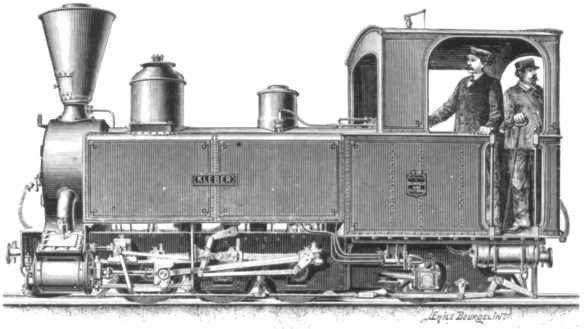
| THE INDUSTRIAL RAILWAY RECORD |
© FEBRUARY 1974 |
KLEBER

Our thanks are due to the Reference Department of the Narrow Gauge Railway Society for making available a copy of J.C. Mackay's "Light Railways for the United Kingdom, India and the Colonies" (Crosby, Lockwood & Son, 1896) in which this engraving of Decauville 1a8 appeared as Fig.6. KLEBER was said to have 97/8in x 12½in cylinders, 2ft 1½in driving wheels and a fixed wheelbase of 4ft 7in; it weighed 13 tons in working order and cost £1,136 new. According to the Decauville list, 128 was an example of their Type 10, built about 1891, and one of several they supplied to the Tramways du Calvados in France. The name recorded by Decauville, however, is HERMANVILLE - not KLEBER. Sundry items of goods and passenger rolling stock were also supplied by Decauville to the Calvados system in June 1891 and August 1892. W.J.K. Davies in "French Minor Railways" (David & Charles, 1965) mentions that the Calvados was one of the two demonstration lines laid down by Decauville, the other being the more well-known Tramway de Pithiviers à Toury.
"An ANGLO-SCANDINAVIAN syndicate has been formed for the construction of a railway from the Ruotivare and Wallati iron mountains, in Swedish Lapland, to the Norwegian coast. ... The railway, which would be built on the Decauville system, is estimated to cost about £200,000."
("Iron," 29th May 1891. - KPP)
"The first locomotive engine built in Australia [a 2‑4‑2 tank] has just been completed at the works of Messrs David Munro & Co in Melbourne, for the Victorian Government Railways." ("Iron", 20th January 1893. - KPP)
"The Pontilov Works, Russia, are opening new shops designed especially for building locomotives, a State order for twenty-eight of which has been received." ("Iron", 3rd February 1893. - KPP)
'Supply of a steam dredger, 4,000 metres of portable steel railway, 0.60 metre gauge, 60 tip‑waggons, and two 6‑ton locomotives. Estimate, 181,540 pesetas. Conditions from La Junta de Obras del rio Guadalquivir y Puerto de Sevilla, Spain.'
(From "Industries & Iron," issue dated 16th June 1893. Compare with the 1892 advertisement which was reprinted on page 40 of RECORD 36. - KPP)